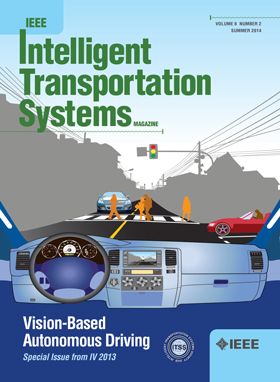何时完成超车动作才安全?模拟驾驶员超越骑自行车者后返回的决定
IF 7.9
1区 工程技术
Q1 ENGINEERING, CIVIL
IEEE Transactions on Intelligent Transportation Systems
Pub Date : 2024-10-04
DOI:10.1109/TITS.2024.3454768
引用次数: 0
摘要
对于骑自行车的人来说,被超车意味着安全风险,可能会被超车的司机侧滑或剐蹭。对于驾驶员来说,这种超车动作极具挑战性,他们不仅需要决定何时启动超车动作,还需要把握好返回的时间以完成超车动作。在迎面来车的情况下,完成超车动作的问题还包括平衡正面与侧面碰撞的风险。主动安全系统,如盲点或前撞预警系统,或最近出现的自动驾驶功能,可以帮助驾驶员避免此类碰撞并成功完成超车动作。然而,此类系统必须谨慎地与驾驶员互动,防止出现错误警报,从而降低驾驶员对系统的信任度。在本研究中,我们开发了一个驾驶员行为模型,用于分析驾驶员在骑车超越行人时的回车起始点,从而改进此类安全系统。为了提供有关驾驶员行为的累积证据,我们使用了两个不同来源的数据:测试轨道和自然驾驶。我们为这两个数据集开发了贝叶斯生存模型,该模型可在当前情况的输入随时间变化的情况下预测驾驶员返回的概率。我们对模型进行了样本内和样本外评估。两个模型都表明,驾驶员会利用骑车人的位移来确定其返回决策的时间,如果迎面而来的车辆出现且距离较近,则会加速其返回决策。我们讨论了如何将模型集成到主动安全系统中,以提高驾驶员的接受度。本文章由计算机程序翻译,如有差异,请以英文原文为准。
When Is It Safe to Complete an Overtaking Maneuver? Modeling Drivers’ Decision to Return After Passing a Cyclist
For cyclists, being overtaken represents a safety risk of possibly being side-swiped or cut in by overtaking drivers. For drivers, such maneuvers are challenging–not only do they need to decide when to initiate the maneuver, but they also need to time their return well to complete the maneuver. In the presence of oncoming traffic, the problem of completing an overtaking maneuver extends to balancing head-on with side-swipe collision risks. Active safety systems such as blind-spot or forward-collision warning systems, or, more recently, automated driving features, may assist drivers in avoiding such collisions and completing the maneuver successfully. However, such systems must interact carefully with the driver and prevent false-positive alerts that reduce the driver’s trust in the system. In this study, we developed a driver-behavior model of the drivers’ return onset in cyclist-overtaking maneuvers that could improve such a safety system. To provide cumulative evidence about driver behavior, we used data from two different sources: test track and naturalistic driving. We developed Bayesian survival models for the two datasets that can predict the probability of a driver returning, given time-varying inputs about the current situation. We evaluated the models in an in-sample and out-of-sample evaluation. Both models showed that drivers use the displacement of the cyclist to time their return decision, which is accelerated if an oncoming vehicle is present and close. We discuss how the models could be integrated into an active-safety system to improve driver acceptance.
求助全文
通过发布文献求助,成功后即可免费获取论文全文。
去求助
来源期刊

IEEE Transactions on Intelligent Transportation Systems
工程技术-工程:电子与电气
CiteScore
14.80
自引率
12.90%
发文量
1872
审稿时长
7.5 months
期刊介绍:
The theoretical, experimental and operational aspects of electrical and electronics engineering and information technologies as applied to Intelligent Transportation Systems (ITS). Intelligent Transportation Systems are defined as those systems utilizing synergistic technologies and systems engineering concepts to develop and improve transportation systems of all kinds. The scope of this interdisciplinary activity includes the promotion, consolidation and coordination of ITS technical activities among IEEE entities, and providing a focus for cooperative activities, both internally and externally.
 求助内容:
求助内容: 应助结果提醒方式:
应助结果提醒方式:


